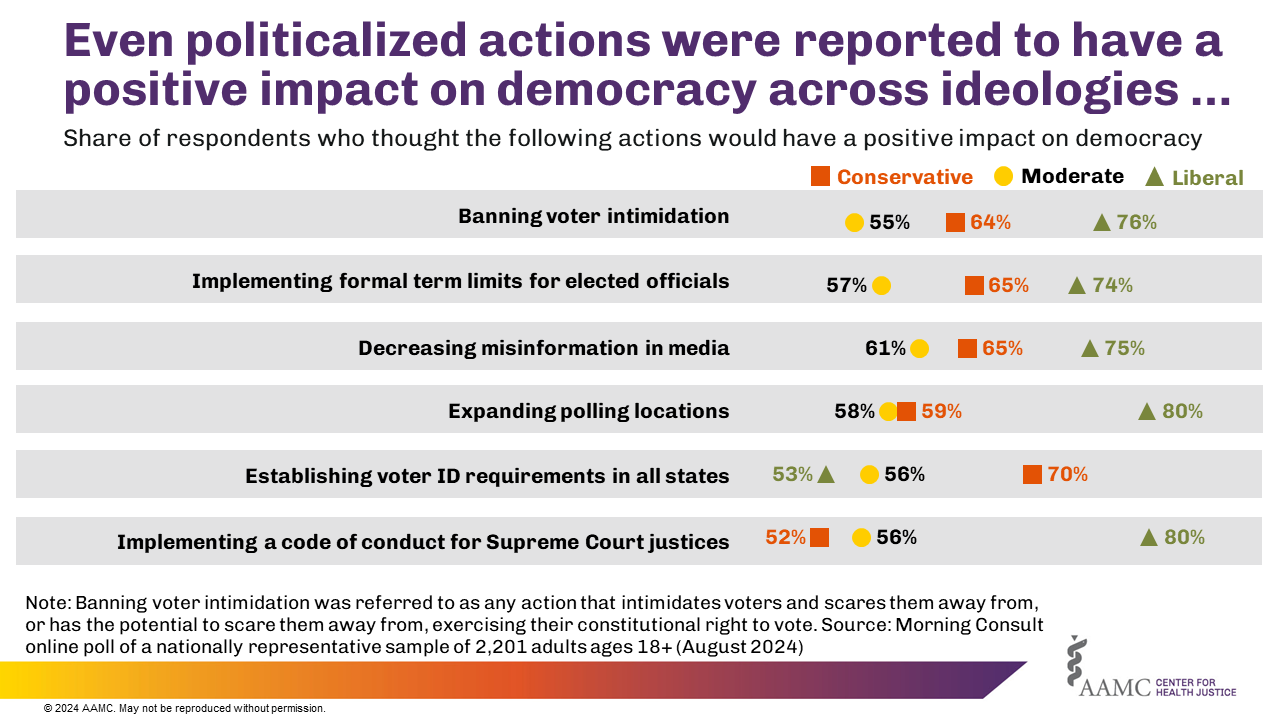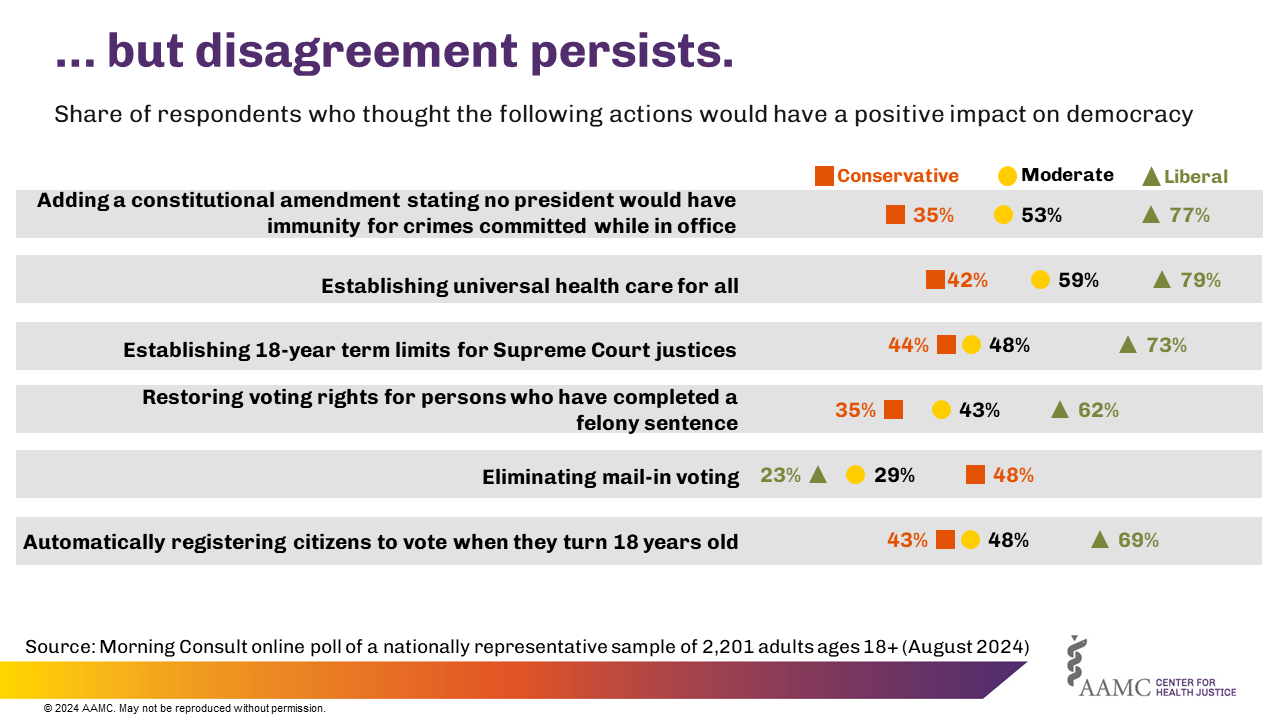Figure 1
Presentation
Participation in civic engagement activities in the last 2 years was a fraction of what's planned in the next 6 months. The figure contains a bar chart that shows survey respondents' participation in civic engagement activities. The y-axis names 10 potential activities, and the x-axis represents the percentage of all adults who said they had participated in that activity in the last 2 years (ranging from 4% to 38%), and the percentage who planned to participate in that activity in the next 6 months (ranging from 28% to 78%).
Values
| Activity | Participation in the last 2 years | Participation in next 6 months |
|---|---|---|
| Vote(d) in a state or federal election | 38% | 78% |
| Vote(d) in a local election | 38% | 76% |
| Sign(ed) petitions | 22% | 59% |
| Deliberately purchase(d) from a company | 14% | 58% |
| Donate(d) money to an organization | 19% | 48% |
| Boycott(ed) a company | 14% | 44% |
| Volunteer(ed) at a community-based organization | 12% | 43% |
| Attend(ed) a local town hall or city council meeting | 8% | 35% |
| Donate(d) money to any political campaign | 8% | 30% |
| Volunteer(ed) time for a national political candidate | 4% | 28% |
Figure 2
Presentation
More than 1 in 5 adults who said they were unlikely to vote in the next 6 months feel like their vote doesn't matter. The figure contains a bar chart that shows survey respondents' endorsements of reasons for not voting in the next 6 months. The y-axis lists 9 reasons, and the x-axis indicates the percentage of all respondents who endorsed that reason (ranging from 6% to 21%).
Values
| Reason | Percentage who endorsed |
|---|---|
| I don’t think my vote really matters | 21% |
| I don’t know enough about the candidates | 20% |
| I don’t like any of the candidates | 18% |
| I don’t have time to vote | 12% |
| Other reason | 9% |
| I’m not aware of an upcoming election | 8% |
| My voting location is inaccessible | 7% |
| I don’t know where to vote | 6% |
| I don’t know how to register to vote | 6% |
Figure 3
Presentation
Across political ideologies, inflation/high cost of living remained the most pressing issue in the United States. A series of four bar charts (one each for all adults, liberals, moderates, and conservatives) shows the percentage of respondents of each category who chose each issue as the most important, second most important, and third most important.
Values
| Political ideology | Issue #1 | Issue #2 | Issue #3 |
|---|---|---|---|
| All adults | Inflation/high cost of living, 61% | Immigration, 34% | Crime/gun violence, 30% |
| Liberals | Inflation/high cost of living, 52% | Abortion access, 40% | Crime/gun violence, 33% |
| Moderates | Inflation/high cost of living, 62% | Health care, 31% | Immigration, 31% |
| Conservatives | Inflation/high cost of living, 69% | Immigration, 59% | National security/terrorism, 28% |
Figure 4a
Presentation
Even politicalized actions were reported to have a positive impact on democracy across ideologies. A scatterplot chart shows the share respondents who thought each of 6 actions would have a positive impact on democracy, stratified by political ideology (conservative, moderate, and liberal). The y-axis lists 6 potential actions, and the x-axis indicates the percentage of respondents who believe the action would have a positive impact on democracy, ranging from 52% to 80%. Note: Banning voter intimidation was referred to as any action that intimidates voters and scares them away from, or has the potential to scare them away from, exercising their constitutional right to vote.
Values
| Actions | Conservative | Moderate | Liberal |
|---|---|---|---|
| Banning voter intimidation | 64% | 55% | 76% |
| Implementing formal term limits for elected officials | 65% | 57% | 74% |
| Decreasing misinformation in media | 65% | 61% | 75% |
| Expanding polling locations | 59% | 58% | 80% |
| Establishing voter ID requirements in all states | 70% | 56% | 53% |
| Implementing a code of conduct for Supreme Court justices | 52% | 56% | 80% |
Figure 4b
Presentation
Continuation of Figure 4a. A scatterplot chart shows the share of respondents who thought each of 6 actions would have a positive impact on democracy, stratified by political ideology (conservative, moderate, and liberal). The y-axis lists 6 potential actions, and the x-axis indicates the percentage of respondents who believe the action would have a positive effect on democracy, ranging from 23% to 79%.
Values
| Actions | Conservative | Moderate | Liberal |
|---|---|---|---|
| Adding a constitutional amendment stating no president would have immunity for crimes committed while in office | 35% | 53% | 77% |
| Establishing universal health care for all | 42% | 59% | 79% |
| Establishing 18-year term limits for Supreme Court justices | 44% | 48% | 73% |
| Restoring voting rights for persons who have completed a felony sentence | 35% | 43% | 62% |
| Eliminating mail-in voting | 48% | 29% | 23% |
| Automatically registering citizens to vote when they turn 18 years old | 43% | 48% | 69% |



